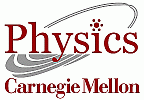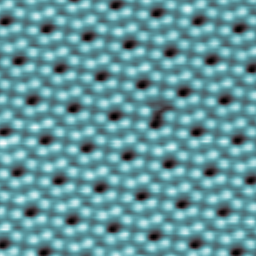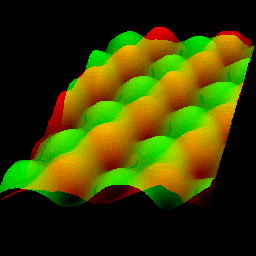 Scanning Tunneling Microscopy
Scanning Tunneling Microscopy Scanning Tunneling Microscopy
Scanning Tunneling Microscopy

First image: STM image of the Si(111)5x5 reconstructed surface.
Second image: STM image of the GaAs(110) surface. Gallium atoms (empty states) are pictured in green, and arsenic atoms (filled states) are shown in red. Click here for postscript file. Click here for gif file.
The research group of Randall M. Feenstra has been active in the field of scanning tunneling microscopy (STM) since 1984. Early work was performed at the IBM T. J. Watson Research Center while Dr. Feenstra was a Research Staff Member there, and since 1995 this activity has continued at Carnegie Mellon. In addition to using the STM for atomic scale imaging, the group has specialized in developing and applying spectroscopic methods for measurement of surface electronic features, particularly on semiconductor surfaces. Some early problems which were studied include:
Since 1993, Prof. Feenstra's group has been active in the area of cross-sectional STM. This method is used to study semiconductor heterostructures, consisting of adjoining layers of semiconductor materials of differing types (a periodic array of such layers is referred to as a superlattice). The heterostructures are cleaved on a (110) crystal plane, thereby exposing a cross-section of the structure and permitting study of the interfaces between layers and/or the properties of the specially grown layers themselves. For a review, see R. M. Feenstra, Semicond. Sci. Technol. 9, 2157 (1994). Early studies focussed on problems of pn doping superlattices, defects in low-temperature-grown GaAs, and interface structure in InAs/GaSb superlattices.
At CMU, the group of Prof. Feenstra has continued this research program in cross-sectional STM. Systems which have been studied include GaN layers in GaAs, and InGaAsP/InGaP laser structures. Further cross-sectional STM studies are currently in progress, on a variety of semiconductor heterostructures which have application for lasers, optical detectors, or novel electronic materials.